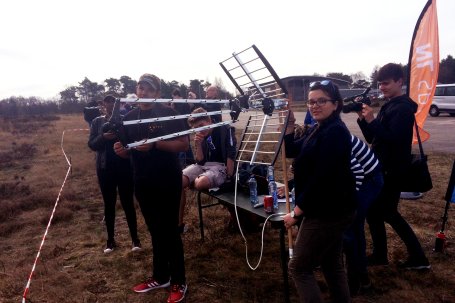High fives for ten CanSats
It's high-fives all around at the Dutch army shooting range in 't Harde, just moments after a rocket releases six CanSat mini-satellites at an altitude of 1 kilometer. Shortly afterwards, a second rocket with four more CanSats follows. Both rockets belong to Delft Aerospace Rocket Engineering (DARE) of TU Delft, while all ten CanSats belong to teams of secondary education pupils from various Dutch schools. They are taking part in the CanSat competition, and among them is the next generation of space scientists and engineers.
In the early morning of 31 March, there's no time yet for high-fives at the shooting range in 't Harde. There is time however for last minute consultation plus final testing and perfection of the precious CanSats. Since November, ten Dutch teams have each been busy designing and assembling a CanSat, which is basically a small satellite the size of a soda can. Soon, all teams will see their designs take flight –on board of a rocket as part of the CanSat competition. After launch, the CanSats will deploy from the rocket at 1 kilometer altitude and parachute down again.
Mission
But that's not all. The real primary mission is to collect data on temperature and air pressure. And so, all eyes focus not only on the CanSats but also on the laptops that will soon show the available data in real time. Furthermore, each team has come up with a secondary mission. Their clever CanSat designs and well-thought-out missions already ensured that these ten teams were chosen as the best out of a total of 25 Dutch teams that previously entered the CanSat competition. The Netherlands Space Office (NSO) has commissioned NEMO-based ESERO NL to organise the competition in cooperation with DARE.
“Our secondary mission consists of collecting camera footage from our CanSat, plus the extension of a landing mechanism”, says 17-year old Paul, a pupil from Bataafs Lyceum in Hengelo. His interest is mostly in physics and astronomy, so plenty of reason to get involved in collecting and analyzing data. A short distance away, Gopal (16) points to aerospace when asked about his specific interests. Speaking Dutch and English fluently, he tells about the secondary mission of the Amsterdam International Community School, which is to calculate windspeed by using gps-data.
Spectacular
“The secondary missions are truly spectacular”, according to Sander Jansen of ESERO NL. “Measuring UV-intensity or doing gas readings, that's remarkable. These pupils are tomorrow's scientists.”
Excitement
At T-minus 30, six CanSats are fitted inside DARE's rocket under mounting excitement. The appearance of a television crew only adds to the excitement.. Nevertheless, the teams report they are already collecting data from their CanSats inside the rocket on the launch platform. The antennas used are mostly self-made.
Launch
At T-minus 0, the rocket shoots up into the sky, followed a short while later by a second rocket. At the apex of the rocket's trajectory, the CanSats are deployed and immediately the laptops receive even more data. The information is still flowing freely as army personnel head into the field to retrieve the CanSats at their respective landing sites. Each CanSats emits its own signal, allowing it to be found.
Winner
The teams are eager to analyse the data back in their classrooms and produce their findings in a science paper. On 21 April it will be determined based on their reports which team will actually win the Dutch CanSat competition. The winning team gets to represent the Netherlands in the European CanSat competition, which is to be held in Bremen between 28 June and 2 July. It means another rocket launch and more excitement for that particular team.

